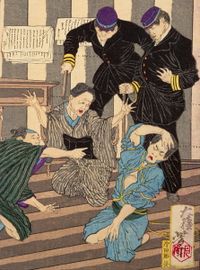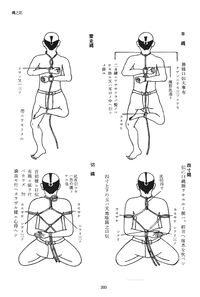Difference between revisions of "Hojojutsu"
| Line 29: | Line 29: | ||
=== 21st Century === | === 21st Century === | ||
| − | == | + | ==Notes== |
<references/> | <references/> | ||
| − | + | ==References (※)== | |
| − | == | + | <references group="※"/> |
| − | <references group=" | ||
==External Links== | ==External Links== | ||
Revision as of 15:03, 18 April 2021
 From Yūbin Hōchi Shinbun 484. Art by Yoshitoshi Tsukioka. |
Hojojutsu is the Art of Rope Capture. Originally developed as a part of Jujutsu during the Warring States period of Japan, it was later adapted as a method to capture, restrain and control criminals during the Edo period. In the Meiji period, Hojojutsu was inherited by Metropolitan Police Departments. In the twentieth century, it has also provided great influence on the development of erotic SM play in Japan up until today.
Alternate Name(s)
捕縄術(Japanese), Hojojutsu, Torinawajutsu
Description
Hojojutsu has two main divisions. The first is called Hayanawa (Fast Binding) is used for the capture and restraint of a resisting opponent. The second is called Honnawa (Formal Binding. Hon is an abbreviation of honshiki[1]) and is used for the transport, escort and punishment of a prisoner.
History

Warring States Period (15th-17th c.)
Edo Period (1603 - 1868)
As Japan is pacified and brought under the authority of the Tokugawa shogunate in the early decades of the 1600s, hojojutsu moves into law enforcement in the larger towns and cities.
Meiji Period (1868 - 1912)
After a struggle between forces claiming loyalty to the emperor and those to the Tokugawa, the Tokugawa shogunate is brought to an end and a new government is established. Law enforcement practice is reorganized along European models, and hojojutsu gradually becomes more simplified and limited in use.
20th Century
21st Century
Notes
- ↑ According to Zukai Hojojutsu by Seiko Fujita.
References (※)